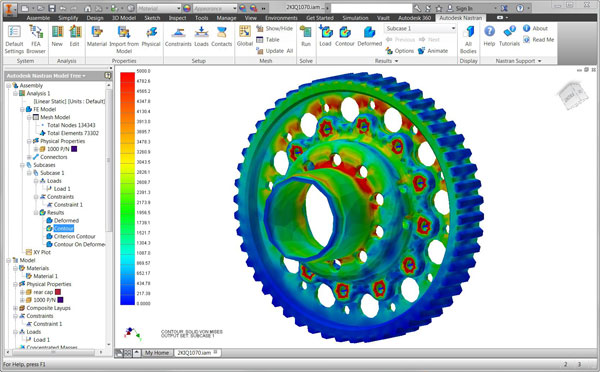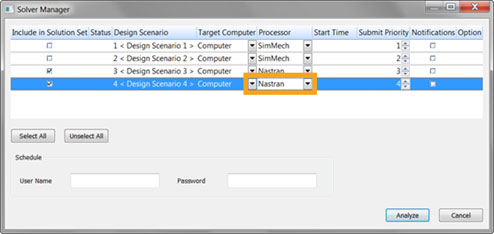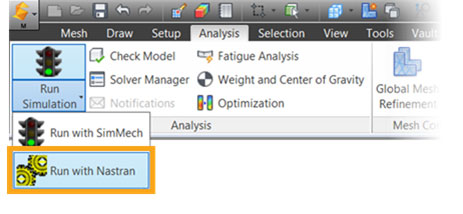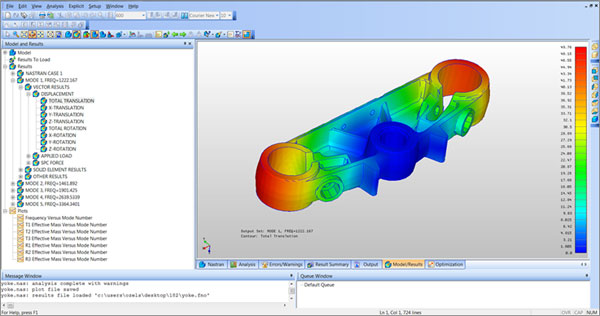
The new Nastran In-CAD works within both Autodesk Inventor and SolidWorks.
Latest News
August 19, 2014
 The new Nastran In-CAD works within both Autodesk Inventor and SolidWorks. Image courtesy of Autodesk.
The new Nastran In-CAD works within both Autodesk Inventor and SolidWorks. Image courtesy of Autodesk.Since 2008, Autodesk has invested in simulation software, adding the capabilities of Moldflow, Algor, CFdesign and Firehole Composites to its product line. Each addition added one more function — molding techniques, structural mechanics, computational fluid dynamics and composites analysis — to the company’s design, lifestyle and simulation toolbox. With the goal of helping customers create ever smaller, lighter, smarter and more-connected products, Autodesk has made another strategic move, tapping the power of industry-standard Nastran solver code. With Autodesk’s product launch of Autodesk Nastran 2015 and Autodesk Nastran In-CAD 2015, the company completes its May acquisition of NEi Software and strengthens its support of efficient digital prototyping across the product cycle.
Derrek Cooper, director, Autodesk Simulation products, says, “To get the masses to do simulation and push multi-physics into the design space, you have to have ‘environmentally friendly’ materials. The software must address how to go from CAD to a mesh, how to handle large, complex models, and how to see an entire assembly simulated.” By adding NEi Nastran to Autodesk’s simulation flow, says Cooper, users now have another way to do all this, with a better way to access Nastran’s well-known capabilities in the up-front design space.
Two Autodesk Nastran Options
Two versions of the simulation product are available. For experienced Nastran engineers, Autodesk Nastran 2015 offers a higher level of simulation sophistication in a stand-alone, scalable package that can run on a desktop and/or take advantage of cloud resources as needed. For designers, the new Autodesk Nastran In-CAD 2015 package lets them do more complex analyses with different physics than before. Interestingly, Autodesk will firmly support the existing Nastran SolidWorks In-CAD package, and may even develop other CAD-centric offerings, such as a Nastran In-CAD for Creo from PTC.
 The Solver Manager enables end users to schedule and run multiple scenarios from a single dialog window. Image courtesy of Autodesk.
The Solver Manager enables end users to schedule and run multiple scenarios from a single dialog window. Image courtesy of Autodesk.Successful up-front simulation must answer such questions as: Will my part fail? How light can I make it? Will it overheat? It must also answer those types of questions either inside the designer’s regular tools or at least easily alongside that software. Mitch Muncy, formerly of NEi Software and now Autodesk Simulation Nastran product manager, says that the new Autodesk products have embedded strong non-linear analysis capabilities such as buckling, normal modes, assembly modeling with contacts, transient response, random response, frequency response, impact analysis and drop test, all set up according to the familiar Nastran structure.
“Autodesk Simulation Mechanical 2015 has been enhanced,” explains Muncy, “so that you can go directly from here into the Autodesk Nastran solver.” All the previous capabilities are still there but now you can do a linear analysis both ways (your choice of solver, SimMech or Nastran is a simple click in the drop-down menu) and compare the results. A new editor helps users create the required “card deck” format for input to a Nastran simulation, and a real-time solver and output log tool ships with the software for managing the visual results. Muncy also notes that while people had gotten the impression it was necessary to dumb-down analysis to bring it into CAD, Autodesk Nastran In-CAD instead elevates CAD users to let them do advanced analysis in a familiar environment. Autodesk resellers will have improved training and be certified to help users with Nastran operations.
 Autodesk Simulation Mechanical 2015 allows users to go directly into the Autodesk Nastran solver. Image courtesy of Autodesk.
Autodesk Simulation Mechanical 2015 allows users to go directly into the Autodesk Nastran solver. Image courtesy of Autodesk.Autodesk’s Simulation Strategy
Looking to the future, the company continues to expand beyond CAD into CAE. Autodesk discussed the six elements of its simulation strategy, which will particularly address customer needs for working with smart machines, advanced materials and additive manufacturing:
- Open – multi-CAD, multi-CAE, with no charge for every translation. For example, its composite tool works with Dassault Systèmes SIMULIA’s Abaqus
- Integrated – more multi-physics capabilities will be supported, plus all Autodesk tools work with each other, with PLM tools and with visualization tools
- Purpose-built – tools are available for the designer, engineer and analyst. Autodesk is creating more tailored solutions and more up-front analysis functions
- Optimizing – supporting parametric experiments has become a critical aspect of efficient design. Users can visualize design studies with an easy-to-see “film-strip” presentation of each variation
- Flexibility – this will become more and more important for licensing models, supporting day-by-day cloud usage. Autodesk continues to expand options for either/or use of simulation tools on the cloud, on a desktop or an iPad; it also knows that users still work in 1D, 2D and 3D as appropriate and will continue that support
- Advanced – applications are needed for more than just composites, so foams, blended materials and nano-materials must all have accurate and validated material properties as input for analysis. The company is increasing joint efforts with DSM, DuPont, etc. to provide such information
At a recent press event, Cooper presented an Autodesk view of what industry needs in future simulation technologies, from more customization options of explicit transient analyses to more detailed what-if simulations of composite parts built by different manufacturing configurations. Connecting design and manufacturing is another development project that would allow parts and assemblies to be simulated “as manufactured,” with the results looped back into design. One forward-looking product already available is FlowDesign, an automated external-flow wind tunnel simulation that is a one-click action within Autodesk Alias.
Perhaps the ultimate goal is the creation of a unified CAE simulation platform that presents a general modeling process analogous to the typical CAD software interface. It would operate on simplified, optimized geometry and perform simulations in the cloud, with results readily available for sharing and comparison to saved versions. Automatic definition of loads and boundary conditions will be a critical element of making this work for a broader spectrum of users.
Below are some video demonstrations of Autodesk Nastran that were produced by Autodesk:
Subscribe to our FREE magazine, FREE email newsletters or both!
Latest News
About the Author
Pamela Waterman worked as Digital Engineering’s contributing editor for two decades. Contact her via .(JavaScript must be enabled to view this email address).
Follow DERelated Topics







